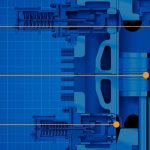Black Smoke from the funnel is a sign of poor maintenance and malfunction of the machinery. It is a serious issue as it violates Marpol 73/78 Annex VI and can lead to inspections and detention of the ship. In a ship with multiple machines the identification of the faulty unit is a difficult task.
The reasons black smoke is wrong are:
1. It indicates that shipkeeping and maintenance is not proper and up to the mark.
2. It indicates the lack of competency of the engineers.
3. It is polluting.
4. It increases the risk of an uptake fire.
Marpol Annex VI has set standards for air pollution and the sulphur content of the exhaust gases. Back smoke indicates that the combustion is incorrect. It suggests a bad fuel efficiency and an increase in the fuel consumption.
Causes of Black Smoke
The dark color of the smoke is caused by suspended fine carbon particles due to incomplete combustion taking place. However the offending machine has to be identified before any corrective action can be made. In marine diesel engines the poor combustion is basically due to two main reasons; the first one is insufficient air supply and the second one is incorrect fuel injection.
The air-related problems in marine diesel engines may be due to the following reasons:
5. The turbocharger air filter is choked.
6. The turbocharger turbine blades are fouled and damaged; therefore it is giving insufficient air to the engine.
7. The turbocharger inlet grid in the exhaust manifold is choked, and therefore the turbocharger is running at low speed.
8. The compressor blades are dirty or damaged.
9. The scavenge ports of the engine may be dirty and choked.
10. The scavenge valves may be faulty or damaged.
11. The nozzle ring of the turbocharger is soiled.
12. The engine room blowers are not supplying sufficient air as the filters are choked.
The fuel-related problems that could cause black smoke are as follows:
13. Low temperature of the fuel causing poor atomization and penetration.
14. The fuel injectors may be dripping causing after-burning.
15. The timing of the fuel pumps may be wrong.
16. The holes of the fuel injectors may have become large by wear.
17. Incorrect spring pressure of the fuel injectors.
18. Wrong grade of fuel or low fuel quality.
19. Incorrect valve lift of the fuel injection valves.
20. Unbalanced engine. Thermal and power balancing needs to be done.
21. Overloaded engine due to governor malfunction.
22. Some units may not be firing leading to overloading of the other units.
23. Scavenge fire has taken place
Finding the Source of Black Smoke
The black smoke could come from the main engine, the three auxiliary engines, the oil fired boiler, the exhaust boiler, or the incinerator. A quick trip to the top of the funnel may indicate the source. Once the exhaust pipe has been identified, it should be traced down to the engine room In case it is the incinerator or the boiler, the fault can be discovered soon, but in engines with multiple units it must be established that whether the fault is of an individual unit of is it common to all.
In case the smoke is traced to a multi-unit diesel engine, the procedure of finding the smoking unit is as follows:
24. The engine must be checked for overloading and the exhaust temperatures of the individual units must be checked. The difference in temperature of the individual unit and the average temperature must not exceed 50 degrees C.
25. The engine must be checked for scavenge fire and the under-piston temperature must be checked of all the units.
26. The fuel racks of all the fuel pumps must be checked and must be within limits.
27. The air filter of the turbocharger blower must be checked for choking.
28. The turbocharger speed must be checked and the temperature drop across the turbocharger must be checked.
29. The fuel temperature must be checked and it must be within the range 120 to 140 degrees C for heavy fuel oil.
30. In the case the problem is only due to a particular cylinder, the units must be cut off one by one and for about two three minutes any change in exhaust must be observed.
Colors of Smoke
The color of the smoke tells about the condition of the machines. The ideal color of the smoke should be transparent to slight grey.
31. A white color indicates presence of water vapor in fuel.
32. Blue colored smoke indicates the presence of lubricating oil in the smoke.
33. Dark black color indicates inefficient combustion or the lack or air. It could also be due to scavenge fire or economizer fire or boiler problems.
Corrective Actions
34. The fuel rack of unit is stuck. The rack can be manually pulled back and the lubrication should be done to remove the fuel sludge. In case the rack does not free up, then the engine must be stopped and the fuel pump replaced with another overhauled one.
35. The turbocharger speed has dropped. In this case either the turbocharger is fouled or has become damaged. Also it could indicate choked nozzle ring or inlet grid. The first thing that must be done is that turbine washing or dry grit cleaning must be attempted. If after two or three washings the turbine does not speed up, then it needs to be opened up and cleaned at the next available opportunity.
36. The temperature drop across the turbocharger has fallen. Generally a temperature drop of around a hundred degrees C should exist across the turbine. In case it is less, the turbocharger efficiency has fallen down and must be corrected. Turbine washing is the first attempted solution and should be followed up by opening and cleaning the turbine.
37. The turbocharger compressor is dirty. Again the water washing of the blower must be done and if it is unsuccessful then open and clean.
38. The air filter is dirty. Change the air filter and adjust the copper wire meshing to the correct density.
39. The fuel pump timing is wrong. Readjust the timing.
40. The fuel injection valves are faulty. Stop the engine and pressure test all the fuel valves and correct any faults.
41. The fuel is of low temperature. Heat up the fuel to the correct temperature as per the manufacturer’s advice.
42. The incinerator is over-stuffed. Put in only the correct charge each time.
43. Incinerator temperature is low. Increase the temperature and preheat before burning sludge and garbage.
44. Boiler air register is wrongly adjusted. Adjust as per the instruction manual.
45. Boiler main burner is dripping. Stop the boiler purge and then overhaul the burner.
46. Economizer fire. Slow down the main engine and give boundary cooling. Soot blow if temperature of fire is low (below metal burning point). After stopping clean thoroughly and inspect for damages.
47. Scavenge fire. Slow down the engine and stop. After cooling down, clean the under piston space and investigate fault.


